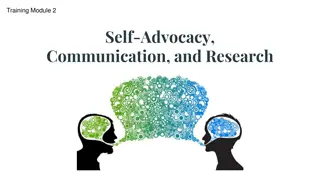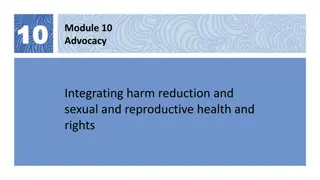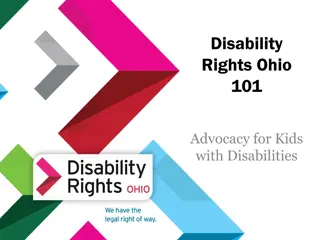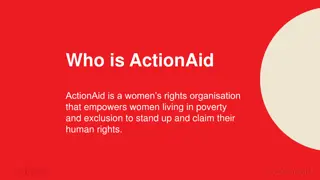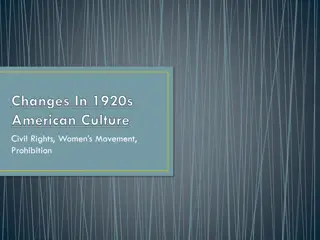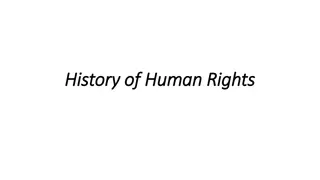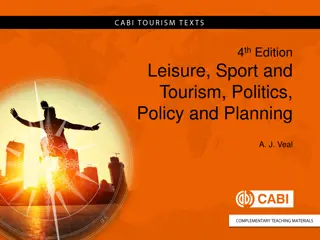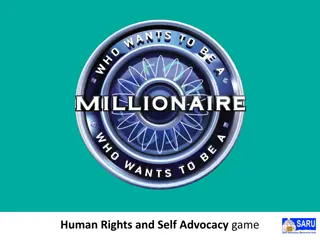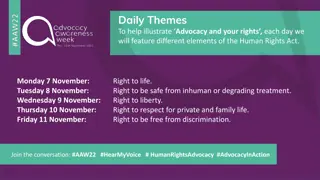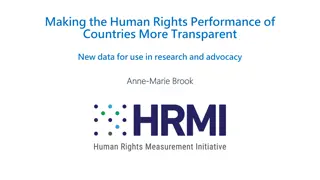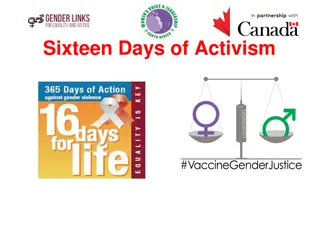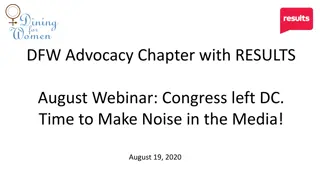Women's Rights Advocacy in Historical Perspective
Mary Wollstonecraft, an English philosopher known for her advocacy of women's rights, particularly in her work "A Vindication of the Rights of Woman," challenged the notion of women's inferiority and lack of education. Her ideas laid the foundation for liberal feminism and influenced feminist movements during the French Revolution. Women's participation in events like the Women's March on Versailles highlighted the struggles faced by women in society, leading to discussions on economic, educational, and political rights for women.
Download Presentation

Please find below an Image/Link to download the presentation.
The content on the website is provided AS IS for your information and personal use only. It may not be sold, licensed, or shared on other websites without obtaining consent from the author.If you encounter any issues during the download, it is possible that the publisher has removed the file from their server.
You are allowed to download the files provided on this website for personal or commercial use, subject to the condition that they are used lawfully. All files are the property of their respective owners.
The content on the website is provided AS IS for your information and personal use only. It may not be sold, licensed, or shared on other websites without obtaining consent from the author.
E N D
Presentation Transcript
Introduction Mary Wollstonecraft (1759-1797), an English Philosopher known for her strong and committed advocacy of women s rights, is most commonly known for her work A Vindication of the Rights of Woman (1792). Wollstonecraft argues in this work that women s inferiority to men is not natural and the reason for this inferiority is their lack of education. According to her, by virtue of being rational beings both men and women should be treated at par with each other. She wanted to make women s lives better not only for themselves but also for their families and more importantly for their husbands. However, she is most widely considered as an advocate of liberal feminism who emphasized the freedom and equality of women.
Womens Struggle for Rights in Historical Perspective Free development of the individual is the core idea in liberalism. But in view of existence of different strands within liberalism different ways are prescribed to achieve this fundamental goal. Despite development of feminist ideas very early in history it was only the publication of Mary s phenomenal work in 1792 that it got systematic and theoretical expression. However, such ideas became popular only with the first wave of feminism in the 1840s and 1850s. The French Revolution in 1789 had a deep impact on almost all aspects of social and political life. So not only did the rights of the common man become important but rights of the minorities, slaves and women too became a matter of discussion.
The French Revolution and Womens March on Versailles Although the French Revolution did not have much impact on women s rights women who participated in the Revolution did have a profound impact on feminism and women s rights. Women s March on Versailles, women s political clubs and their pamphlets, and some of the politically popular figures greatly influenced the perception about the women and the way they were viewed in society. Women were confined to the domestic sphere and were not given an opportunity to participate in the public sphere. They were considered as less rational and hence not capable of taking decisions in public life. French Enlightenment thinker Rousseau too shared the similar view and believed that women had no role in politics.
The French Revolution(contd.) By 1787 women started bringing out brochures that reflected and argued in favour of the rights of women in the fields of education, employment opportunities and marriage rights. Consequently, the consciousness regarding economic and sexual rights generated during the French Revolution was meant to become an important starting point for all future feminist struggles. The March on Versailles on October 5, 1789 was the first major event that marked the role of women in politics . It was a result of the deteriorating economic condition of the country which led to an unexpected increase in the bread prices and extremely low wage rates because of which poor, working class women faced great difficulties in fulfilling even the basic needs of their families.
March on Versailles As a result some of the women took part in riots that were triggered against low wages. But despite such riots there was no food and soon Paris began to starve. In the March on Versailles, women put bread on pikes and marched from Paris to Versailles. In this march men too followed women and they captured the king and brought him with his family to Paris to have a look at the condition of people there. This turned out to be a major game-changer for women as it proved that they too could effectively participate in the cause and that women were not a politically irrelevant class. So it also demonstrated that men and women could work as equals when they were committed to bring about positive changes in society.
Post-French Revolution and Womens Engagement in Politics By 1790, when France had began to function under a representative government, women reformed their ways of struggle and started to engage in politics in a different way. They formed political clubs or became part of different clubs, which were till then an arena only for men. These clubs now with women members came up in different places which showed that women all over were now getting conscious of their rights and political significance. Gradually women and men from these clubs began filing petitions in the National Assembly advocating women s equal right to education and reform in martial laws. Women also came forward to assert their sexual rights and went on to form dual-gender clubs where men and women participated equally in discussion about politics.
Influence on Mary Wollstonecraft Thus, the idea that women and men must have equal legal and political rights dates back to the French Revolution. It also had a profound influence on the thinking of women activists and reformers like Mary Wollstonecraft. Wollstonecraft was a staunch advocate of women s inclusion in public life that was dominated by men. By drawing a connection between the emancipation of women and their socio-economic condition, Wollstonecraft brought both class and family to the political realm. Class and family, which were two important institutions in liberal theory, were politicized now. With this understanding she distinguished herself from other classical liberal thinkers and went on to challenge the basic structural foundation of classical liberal tradition- the public private distinction.
Wollstonecraft and Patriarchy Classical liberalism developed with the distinction between economic power and political power with emphasis on the fact that the former can be attained only with private property and its utilization in the market. In this way an economic sphere was created composed of individual property holders, who were also considered the heads of households. Thus family and economy were considered as natural spheres and as unchanging universal features human life, each being governed by the laws operating in their respective spheres, rule of patriarchy in the case of family and law of competition in the case of economy.
Wollstonecraft and Patriarchy (contd.) Liberals believed that the freedom in each of these spheres needs to be protected and this protection could be provided only by bringing in a third institution, i.e. the state. According to the classical liberals, the state plays the role of a guarantor of rights and liberties in these spheres and this freedom can only be maintained if the private nature of both economy and family is respected (Ferugson, 1999). Thus, classical liberalism was based on the distinction between the public and private sphere and within the liberal tradition emancipation was possible only when this distinction was maintained and there was a proper balance between the two.
Wollstonecraft and Patriarchy (contd.) Within this classical liberal tradition, family and economy were considered as self-regulating private fields. Therefore, aspects of these fields like gender, class and race were considered as the aspects of the private sphere that resulted out of individual choices and preferences. Hence any interference in the activities within this sphere was considered illiberal. Thus, the classical liberals maintained the distinction between the state and civil society. However, classical socialism (19thcentury utopian and scientific socialism) challenged this understanding of self-regulation and argued that the private sphere cannot be considered as fully distinct from the public sphere.
Classical Socialists Classical socialists point out that the inequalities in family and the economy are the product of the changing social relations based on class conflict. Therefore, class, gender and race relations are shaped by the socio-economic interests of the dominant class and the state helps in maintaining this condition of unfreedom of the private sphere. Thus, the classical socialists idea of emancipation lies in transcending this public-private distinction. Wollstonecraft is considered as a bridge between classical liberalism and classical socialism as she wanted create an egalitarian society and was critical of the dominant forms of property by not accepting the public-private dichotomy of the liberals and incorporating socialist ideas into her understanding.
Mary: A Bridge between Classical Liberalism and Classical Socialism Wollstonecraft s ideas are considered by some scholars as radical in the sense that she extended this critique and her understanding to the institution of the family. In this way she is making a departure from the liberal principles as her liberalism is not limited to the economic aspect but also extended to domestic relations. However, Wollstonecraft s understanding goes with the established belief that a family is headed by a male breadwinner and wife or the woman manages the household and serves as a caretaker by performing the roles of mother as well as wife. Indeed, freedom for the middle-class women meant fulfilling their duties as wives and mothers.
Wollstonecraft: A Reluctant Radical Wollstonecraft s radicalism was not in the sense that she was against the public-private dichotomy, rather she was of the opinion that women too should participate in the public sphere. This suggests that perhaps she was not critical of the structural aspects of public-private distinction within the liberal discourse but only the moral and social aspects. Wollstonecraft firmly believed that people are the products of their context and environment.
Marys Critique of Rousseau on Education Both Wollstonecraft and Rousseau were the two philosophers of Enlightenment who stressed the role of education in shaping the lives of individuals. Wollstonecraft was an advocate of women s education and believed that emancipation of women is possible only when they are not discriminated in providing education. This was in contrast to Rousseau s idea on education which is discriminatory. Rousseau argued that education plays an important role in creating a natural man who remains unaffected by the modern society. According to Rousseau the natural goodness of man can come out only through a prescriptive form of education. He ventures into this field by describing the life journey of an imaginary man Emile.
Marys Critique of Rousseau on Education (contd.) Rousseau describes how education shaped his life at every stage of development thus prescribing what kind of education should be provided at each stage. According to Rousseau, when Emile reaches adulthood or becomes a man, he would need a companion. Hence, the last part of the book deals with the education of women. In Rousseau s view both men and women have different virtues with men having the virtue of rationality and women the virtue of sexuality that could be maintained through chastity, gentleness and obedience. Therefore, if the virtues of men and women differ their education should also be different. He was of the opinion that women s biology does not allow them to do men s work.
Marys Critique of Rousseau on Education (contd.) The duties of men and women have a common end, but the duties themselves are different and consequently also the tastes that direct them. Rousseau argues that the role and natural responsibility of women is care-giving, therefore their education should aim at enhancing their caring abilities. They should be trained to accept the constraints and dictates of society. Rousseau believes that we should not try to develop the qualities of men in women. In doing so women would lose their significance and this would deprive them of their true qualities. Rousseau believes that a woman s identity is only in relation to man and therefore her education should be such that she accepts the male authority within the family as this would also ensure that their chastity is protected.
Marys Critique of Rousseau on Education (contd.) A woman s education, according to Rousseau, is important so that she could agree with her husband and her children find her intelligent. In his view this is all that is needed and nothing more than this. Thus the whole education of women ought to be relative to men. It is directed to please them, to be useful to them, to make themselves loved and be honoured by them. So as per Rousseau view woman s education should help her in discharging multiple roles such as educating males when they are young, being caring for them when they are grown up along with tasks such as counseling and consoling them so as to make life agreeable and sweet for them.
Marys Critique of Rousseau on Education (contd.) Most of Rousseau s arguments are rejected by Wollstonecraft. Though she accepted that women are natural care-givers, she rejects Rousseau s claim that women lack the rational capacity that men possess. Wollstonecraft argues that the idea of a perfect wife propounded by Rousseau has brought discrimination and neglect for women and the main reason for this neglect and discrimination is their lack of education. Therefore, she advocates equal education for both men and women. Instead of women s education being relative to men it should be at par with men. Wollstonecraft strongly argues that women have an equal right to education and only an educated woman can be empowered enough to perform their duties well.
Concluding Observations Though liberal feminism is based on the basic ideas of liberalism, it has also challenged its practice in terms of limiting the rights to men and not extending it to women and other minorities. The idea of equality of opportunity, and rights of the women in the public sphere became the defining features of liberal feminism. The first wave of feminism was marked by the demands for equal political rights for women in terms of suffrage rights, and economic rights in terms of property rights. Focus was also on equal education rights for women as it was strongly being argued that women are equally capable as men in terms of rationality and any activity in the public sphere.
Concluding Observations (contd.) Liberal feminism focused on the idea that the individual s position in the social sphere is not natural or biologically determined, rather they have their roots in the processes of social learning. Therefore, they focused in revising this learning process and raise consciousness among women regarding the fact that they are not just meant for domestic work and should try to come out of the traditional role divisions between men and women. So Wollstonecraft has not given just a moral account but a systematic social criticism. The political and social environment do not allow women to develop the basic human faculty of reason.
Concluding Observations (contd.) Regaining the lost dignity of women and make them part of the human species could be possible only when women participate in all walks of life-social, political and cultural. The self-development of women would be possible only through right education and any reform of this sort would be ineffective in a context that denies freedom.






